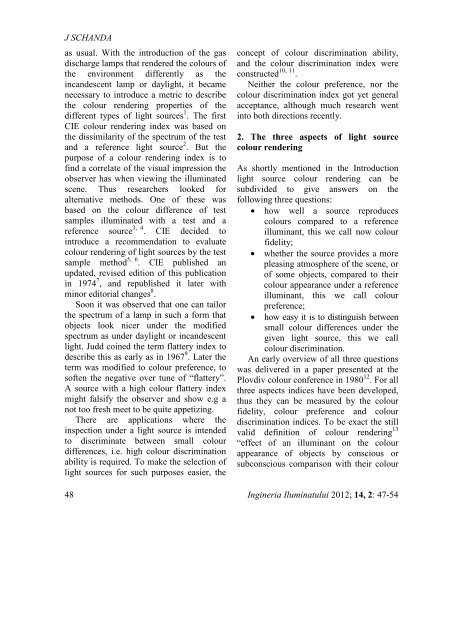Untitled - Journal of Lighting Engineering
Untitled - Journal of Lighting Engineering
Untitled - Journal of Lighting Engineering
You also want an ePaper? Increase the reach of your titles
YUMPU automatically turns print PDFs into web optimized ePapers that Google loves.
J SCHANDA<br />
as usual. With the introduction <strong>of</strong> the gas<br />
discharge lamps that rendered the colours <strong>of</strong><br />
the environment differently as the<br />
incandescent lamp or daylight, it became<br />
necessary to introduce a metric to describe<br />
the colour rendering properties <strong>of</strong> the<br />
different types <strong>of</strong> light sources 1 . The first<br />
CIE colour rendering index was based on<br />
the dissimilarity <strong>of</strong> the spectrum <strong>of</strong> the test<br />
and a reference light source 2 . But the<br />
purpose <strong>of</strong> a colour rendering index is to<br />
find a correlate <strong>of</strong> the visual impression the<br />
observer has when viewing the illuminated<br />
scene. Thus researchers looked for<br />
alternative methods. One <strong>of</strong> these was<br />
based on the colour difference <strong>of</strong> test<br />
samples illuminated with a test and a<br />
reference source 3,u4 . CIE decided to<br />
introduce a recommendation to evaluate<br />
colour rendering <strong>of</strong> light sources by the test<br />
sample method 5,u6 . CIE published an<br />
updated, revised edition <strong>of</strong> this publication<br />
in 1974 7 , and republished it later with<br />
minor editorial changes 8 .<br />
Soon it was observed that one can tailor<br />
the spectrum <strong>of</strong> a lamp in such a form that<br />
objects look nicer under the modified<br />
spectrum as under daylight or incandescent<br />
light. Judd coined the term flattery index to<br />
describe this as early as in 1967 9 . Later the<br />
term was modified to colour preference, to<br />
s<strong>of</strong>ten the negative over tune <strong>of</strong> “flattery”.<br />
A source with a high colour flattery index<br />
might falsify the observer and show e.g a<br />
not too fresh meet to be quite appetizing.<br />
There are applications where the<br />
inspection under a light source is intended<br />
to discriminate between small colour<br />
differences, i.e. high colour discrimination<br />
ability is required. To make the selection <strong>of</strong><br />
light sources for such purposes easier, the<br />
concept <strong>of</strong> colour discrimination ability,<br />
and the colour discrimination index were<br />
constructed 10, 11 .<br />
Neither the colour preference, nor the<br />
colour discrimination index got yet general<br />
acceptance, although much research went<br />
into both directions recently.<br />
2. The three aspects <strong>of</strong> light source<br />
colour rendering<br />
As shortly mentioned in the Introduction<br />
light source colour rendering can be<br />
subdivided to give answers on the<br />
following three questions:<br />
• how well a source reproduces<br />
colours compared to a reference<br />
illuminant, this we call now colour<br />
fidelity;<br />
• whether the source provides a more<br />
pleasing atmosphere <strong>of</strong> the scene, or<br />
<strong>of</strong> some objects, compared to their<br />
colour appearance under a reference<br />
illuminant, this we call colour<br />
preference;<br />
• how easy it is to distinguish between<br />
small colour differences under the<br />
given light source, this we call<br />
colour discrimination.<br />
An early overview <strong>of</strong> all three questions<br />
was delivered in a paper presented at the<br />
Plovdiv colour conference in 1980 12 . For all<br />
three aspects indices have been developed,<br />
thus they can be measured by the colour<br />
fidelity, colour preference and colour<br />
discrimination indices. To be exact the still<br />
valid definition <strong>of</strong> colour rendering 13<br />
“effect <strong>of</strong> an illuminant on the colour<br />
appearance <strong>of</strong> objects by conscious or<br />
subconscious comparison with their colour<br />
48 Ingineria Iluminatului 2012; 14, 2: 47-54
















